
The Fatimid Caliphate was a caliphate extant from the tenth to the twelfth centuries AD under the rule of the Fatimids, an Isma'ili Shi'a dynasty. Spanning a large area of North Africa and West Asia, it ranged from the western Mediterranean in the west to the Red Sea in the east. The Fatimids trace their ancestry to the Islamic prophet Muhammad's daughter Fatima and her husband, ‘Ali ibn Abi Talib, the first Shi‘a imam. The Fatimids were acknowledged as the rightful imams by different Isma‘ili communities as well as by denominations in many other Muslim lands and adjacent regions. Originating during the Abbasid Caliphate, the Fatimids conquered Ifriqiya and established the city of al-Mahdiyya. The Fatimid dynasty ruled territories across the Mediterranean coast and ultimately made Egypt the center of the caliphate. At its height, the caliphate included—in addition to Egypt—varying areas of the Maghreb, Sicily, the Levant, and the Hejaz.

Medieval Muslim Algeria was a period of Muslim dominance in Algeria during the Middle Ages, spanning the millennium from the 7th century to the 17th century. The new faith, in its various forms, would penetrate nearly all segments of society, bringing with it armies, learned men, and fervent mystics; in large part, it would replace tribal practices and loyalties with new social norms and political idioms.
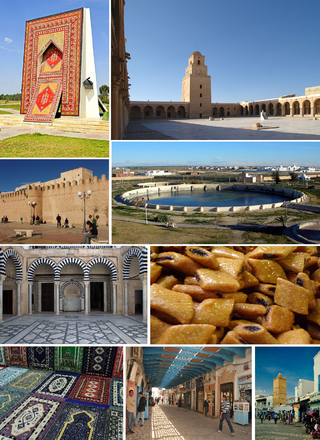
Kairouan, also spelled El Qayrawān or Kairwan, is the capital of the Kairouan Governorate in Tunisia and a UNESCO World Heritage Site. The city was founded by the Umayyads around 670, in the period of Caliph Mu'awiya ; this is when it became an important centre for Sunni Islamic scholarship and Quranic learning, attracting Muslims from various parts of the world. The Mosque of Uqba is situated in the city.
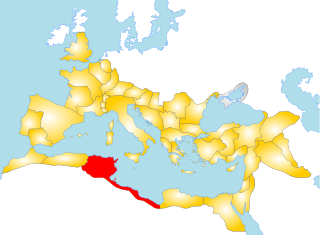
Ifriqiya, also known as al-Maghrib al-Adna, was a medieval historical region comprising today's Tunisia and eastern Algeria, and Tripolitania. It included all of what had previously been the Byzantine province of Africa Proconsularis and extended beyond it, but did not include the Mauretanias.
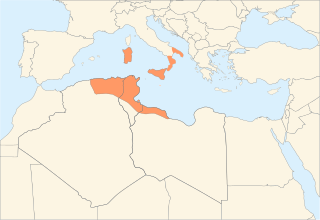
The Aghlabids were an Arab dynasty centered in Ifriqiya from 800 to 909 that conquered parts of Sicily, Southern Italy, and possibly Sardinia, nominally as vassals of the Abbasid Caliphate. The Aghlabids were from the Najdi tribe of Banu Tamim and adhered to the Mu'tazilite rationalist doctrine within Hanafi Sunni Islam, which they imposed as the state doctrine of Ifriqiya. They ruled until 909 when they were conquered by the new power of the Fatimids.

The Zirid dynasty, Banu Ziri, was a Sanhaja Berber dynasty from modern-day Algeria which ruled the central Maghreb from 972 to 1014 and Ifriqiya from 972 to 1148.
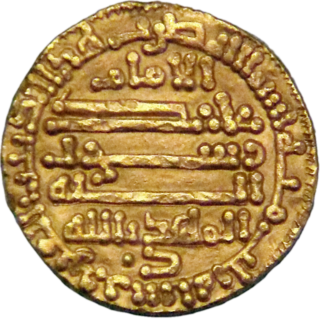
Abū Muḥammad ʿAbd Allāh ibn al-Ḥusayn, better known by his regnal name al-Mahdī biʾllāh, was the founder of the Isma'ili Fatimid Caliphate, the only major Shi'a caliphate in Islamic history, and the eleventh Imam of the Isma'ili branch of Shi'ism.

Abū Yazīd Makhlad ibn Kaydād, also known as the Man on the Donkey, was an Ibadi Berber of the Banu Ifran tribe who led a rebellion against the Fatimid Caliphate in Ifriqiya starting in 944. Abu Yazid conquered Kairouan for a time, but was eventually driven back and defeated by the Fatimid caliph al-Mansur bi-Nasr Allah.
The Kutama was a Berber tribe in northern Algeria classified among the Berber confederation of the Bavares. The Kutama are attested much earlier, in the form Koidamousii by the Greek geographer Ptolemy.

Abu Tahir Isma'il, better known by his regnal name al-Mansur Billah, was the third caliph of the Fatimid Caliphate in Ifriqiya, ruling from 946 until his death. He presided over a period of crisis, having to confront the large-scale Kharijite rebellion of Abu Yazid. He succeeded in suppressing the revolt and restoring the stability of the Fatimid regime.
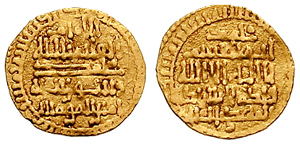
Abū al-Qāsim Muḥammad ibn ʿAbd Allāh, better known by his regnal name al-Qāʾim (القائم) or al-Qāʾim bi-Amr Allāh, was the second caliph of the Fatimid dynasty, ruling in Ifriqiya from 934 to 946. He was the twelfth Isma'ili Imam, succeeding his father Abd Allah al-Mahdi Billah.

Ibrahim I ibn al-Aghlab was the first Emir of the Ifriqiya from Aghlabid family (800-812).

Abu Mudhar Ziyadat Allah III was the eleventh and last Emir of the Aghlabids in Ifriqiya (903–909).

Abu Ishaq Ibrahim II ibn Ahmad was the Emir of Ifriqiya. He ruled from 875 until his abdication in 902. After the demise of his brother, Ibrahim was endorsed as emir where he took steps to improve safety in his domain and secured the development of commercial activities. He improved public works, such as building a vast reservoir, erecting walls as well as the development of mosques and his Raqqada palace.
Abu Abdallah al-Husayn ibn Ahmad ibn Muhammad ibn Zakariyya, better known as Abu Abdallah al-Shi'i, was an Isma'ili missionary (dāʿī) active in Yemen and North Africa. He was successful in converting and unifying a large part of the Kutama Berber tribe, leading them on the conquest of Ifriqiya from 902 to 909 and the overthrowing of the Aghlabid dynasty. This ultimately led to the establishment of the Fatimid Caliphate in Ifriqiya under the Imam–caliph Abdullah al-Mahdi Billah. However, Abdullah al-Mahdi Billah quickly fell out with Abu Abdallah and had Abu Abdallah executed on 28 February 911.

Tobna, also known by the ancient names of Tubunae or Thubunae, is a ruined former city in Batna Province of Algeria, located just south of the modern city of Barika. From this position, it once controlled the eastern part of the Hodna region, while M'Sila did the west. It flourished from the time of the Roman Empire through the Islamic Middle Ages, until it was sacked and destroyed by the Banu Hilal in the 11th century, after which it was finally abandoned.

The History of early Islamic Tunisia opens with the arrival of the Arabs who brought their language and the religion of Islam, and its calendar. The Arab conquest followed strategy designed by the Umayyad Caliphate regarding its long-term conflict with the Byzantine Empire. The native Berbers eventually converted to Islam. They might have seen some similarities between themselves and the Arabs, in similar cognate culture, such as familiarity with a pastoral way of life. The first local Islamic ruling house, the Aghlabids, consisted primarily of rule by leading members of this Arab tribe. Fundamental elements of Islamic civilization were established. Although accepting Islam, many Berbers nonetheless resisted rule by the Arabs, establishing the Rustamid kingdom following the Kharijite revolt. Next in Ifriqiya (Tunisia) arose the Shia Fatimids, inspired by a few immigrants from the east yet consisting for the most part of Ifriqiya Berbers. The Fatimids later expanded their rule east, through conquest by Berber armies of Egypt, and established their caliphate there which came to include Syria and the Hejaz.
Al-Hasan ibn Ahmad ibn Abi Khinzir was a Fatimid military commander who served as the first Fatimid governor of Kairouan and of Sicily.
Khalil ibn Ishaq al-Tamimi was an Arab military commander, in the service of the Fatimid Caliphate as head of the Arab jund of Ifriqiya. He was active as early as 913. From 937 to 941 he was the governor of Sicily, leading the brutal suppression of a large-scale anti-Fatimid revolt. He was captured and killed in 944, during the anti-Fatimid rebellion of Abu Yazid.
The 1016 Ismaili massacre in Ifriqiya was a massacre of the Isma'ili Shia Muslim inhabitants of Ifriqiya by Sunni Muslims under the leadership of Maliki jurists and scholars. Sunni riots started in October 1016 in Qayrawan and later spread to other towns, killing about 20,000 Shi'ites.